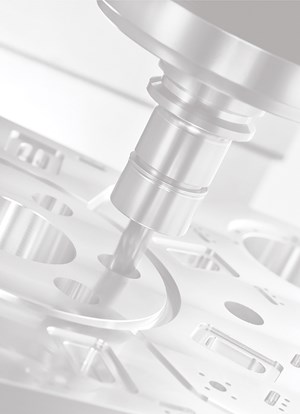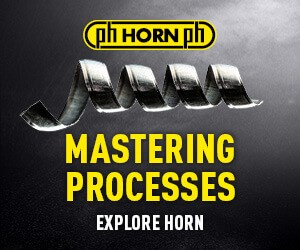Measuring Torque, Thrust Force for Smart Drilling Operations
To monitor drilling operations for smart manufacturing solutions, torque and thrust force can be measured.
Share


To support the integration of digital technologies, low-cost and high-accuracy sensors are a key capability. Important industries for smart manufacturing implementation include automotive, medical, aerospace and agriculture manufacturing, for example. In aerospace, time and cost can be reduced using in-process torque and thrust force measurements to assess tool wear and recommend tool changes when drilling metals, composites and metal-composite structures. Smart solutions are necessary, because millions of holes are necessary for aerospace structure assembly, including riveted and bolted joints. To provide drilling torque and thrust force measurement, a dynamometer is described in Figure 1. This description demonstrates that smart manufacturing can be achieved without high cost or complexity.
In the flexure-based (constrained-motion) design, the drilling torque is determined from the rotational displacement of the workpiece mounting stage and the drilling thrust force is determined from the translational displacement of the platform. Figure 1 displays the constrained-motion drilling dynamometer (CMDD) design. The mounting stage is radially supported by 10 flexure elements (labeled “spoke” in Figure 1) that provide rotation, q, about the vertical axis. The platform is supported by four flexure elements (labeled “leaf”) that provide vertical, z, translation. The mounting stage and platform displacements are measured using Hall effect sensors and then scaled by the corresponding stiffness to calculate the drilling torque and thrust force.
The monolithic platform in Figure 1 was fabricated from 6061-T6 aluminum. The rotational stiffness (Kθ) of the mounting stage depends on the number of spokes, the spoke length (Ls), width (bs) and thickness (ts), and the mounting stage radius (r). The vertical displacement is enabled by four 6061-T6 aluminum flexure elements arranged in a parallelogram configuration. The (vertical) translational stiffness (Kz) depends on the number of flexure elements and the leaf length (Ll) width (bl) and thickness (tl).
Because the rotational and translational stiffness values depend on the flexure element thickness and length, contour plots were generated to show lines of constant stiffness as a function of these key design parameters. See Figure 2, where the red circles identify the design combinations and corresponding stiffnesses.
Fig. 2: Lines of constant stiffness based on spoke and leaf thickness (t) and length (L). For rotational stiffness, Kθ (Nm/rad), the axes represent spoke dimensions. For translational stiffness, Kz (N/m), the axes represent leaf dimensions.
Hall effect sensors detect the presence and magnitude of a magnetic field by measuring a voltage difference induced by the magnetic field across an electrical conductor. The magnitude of the voltage difference is directly proportional to the magnetic field strength. Bipolar Hall effect sensors are applied here to measure the mounting stage and platform displacements. A dual magnet, opposite pole configuration is implemented so that, when the magnets translate across the sensing element, the response varies linearly from the low to high voltage saturation levels. A Texas Instruments DRV5055A2 Hall effect sensor and two N52 gold-plated neodymium disc magnets provided the required performance; see Figure. 3. This combination had a linear range of 250 µm and a sensitivity of 36.8 µm/V (0.2 mm sensor-magnet air gap).

Fig. 4: Drilling setup on a DMG-Mori DMU 75 with an aluminum sample bolted to the CMDD mounting stage. The drill is clamped in the rotating dynamometer.
Drilling tests were conducted to compare CMDD results to those obtained from a commercially available, rotating dynamometer (Kistler 9170A1312). Two workpiece materials (6060 aluminum and DIN EN 1.4301 stainless steel) were selected and the samples were bolted to the CMDD. Blind hole drilling tests were performed with 8-mm and 12-mm diameter, two flute, solid carbide, TiAlN coated drills with 140 deg point angles (Kennametal 1913487 and 1913502). The drilling parameters are shown in Table 1. The drilling tests were completed using a DMG-MORI DMU 75 MonoBlock five-axis CNC machining center. A Stoddard solvent (WD-40) was applied to the workpiece surface prior to drilling to prevent the chips from adhering to the tool. A center drilling operation was performed prior to the blind hole drilling tests; see the setup in Figure 4. To evaluate repeatability, three holes were drilled for each parameter combination.
| Material | 6060 aluminum | 1.4301 stainless steel | ||
| Diameter (mm) | 8 | 12 | 8 | 12 |
| Feed (mm/min) | 573, 716, 860 | 572, 764 | 143, 191 | 127, 170 |
| Spindle speed (rpm) | 3581 | 2387 | 1592 | 1061 |
| Depth (mm) | 12 | 18 | 12 | 12 |
Table 1: Drilling parameters.
Comparisons of drilling torque and thrust force values are displayed in Figures 5 and 6. It is seen in Figure 5 that the CMDD drilling torque demonstrates overlapping error bars with the rotating dynamometer and mean values that differ by 8.2% or less. In Figure 6, the CMDD thrust force again demonstrates overlapping error bars with the rotating dynamometer and the maximum difference is 7.9%.
Fig. 5: Radar chart comparing the CMDD and rotating dynamometer drilling torque (Nm). Each radial axis represents a combination of drilling parameters and the error bars represent two standard deviations (95% confidence interval). Note the change in scale along each axis.
Related Content
Understanding Process Damping in Milling Operations
Despite the advances in modeling machining operations over the past decades, process damping remains a topic of interest, including new tool designs that increase the effect.
Read MoreFinding the Right Tools for a Turning Shop
Xcelicut is a startup shop that has grown thanks to the right machines, cutting tools, grants and other resources.
Read MorePicking the Right End Mill
Kennametal global product manager Katie Myers explains how cutting tool features can impact machining strategies for different materials.
Read MoreMaximizing Milling Operations With the Right Cutter
Selecting milling cutters that are suited to the task at hand can reduce cycle times, improve part quality and save money. Here’s where three milling cutters excel.
Read MoreRead Next
OEM Tour Video: Lean Manufacturing for Measurement and Metrology
How can a facility that requires manual work for some long-standing parts be made more efficient? Join us as we look inside The L. S. Starrett Company’s headquarters in Athol, Massachusetts, and see how this long-established OEM is updating its processes.
Read More































